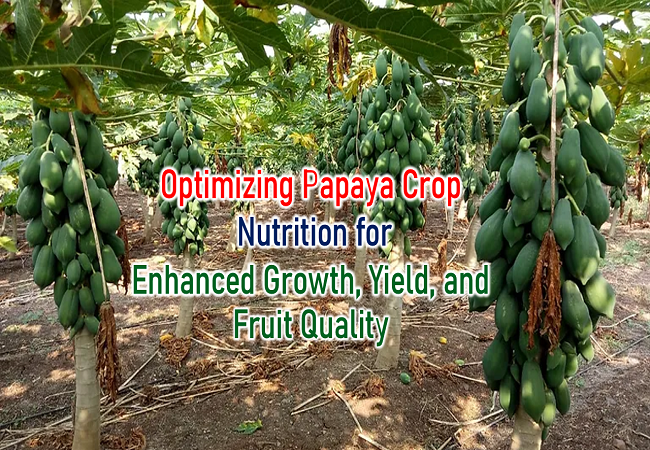Optimal fertilizer support for enhancing Papaya Crop Flowering, Fruit Setting, and fruit taste: Explore detailed strategies encompassing nutrient management, including types of fertilizers, application methods, and timing, to achieve superior results in both yield and fruit quality.
Optimizing fertilizer support for enhancing papaya crop flowering, fruit setting, and fruit taste involves a comprehensive approach that considers nutrient management, fertilizer types, application methods, and timing. Here's a detailed examination of strategies to achieve superior results in both yield and fruit quality:
Soil Analysis: Before applying fertilizers, conduct a soil analysis to understand its nutrient composition and pH level. This analysis will guide you in determining which nutrients are deficient and need supplementation.
Nutrient Requirements: Papaya plants require several key nutrients for optimal growth, flowering, and fruit development. These include nitrogen (N), phosphorus (P), potassium (K), calcium (Ca), magnesium (Mg), sulfur (S), iron (Fe), manganese (Mn), zinc (Zn), copper (Cu), and boron (B). Each of these nutrients plays a specific role in the plant's physiological processes.
Fertilizer Types:
Nitrogen (N): Nitrogen is essential for vegetative growth and overall plant vigor. Use nitrogen-rich fertilizers such as urea, ammonium sulfate, or organic sources like composted manure.
Phosphorus (P): Phosphorus promotes root development, flowering, and fruiting. Use phosphorus-rich fertilizers such as triple superphosphate or bone meal.
Potassium (K): Potassium enhances fruit quality, flavor, and resistance to diseases and stress. Potassium sulfate or potassium chloride are common potassium sources.
Secondary and Micronutrients: Ensure the availability of secondary nutrients like calcium, magnesium, and sulfur, as well as micronutrients like iron, manganese, zinc, copper, and boron. These can be supplied through balanced fertilizers or specific nutrient supplements.
Application Methods:
Broadcast Application: Spread granular fertilizers evenly over the soil surface around the papaya plants, avoiding direct contact with the stems.
Band Application: Place fertilizers in bands alongside the planting rows or around individual plants for more targeted nutrient delivery.
Foliar Application: Spraying nutrient solutions directly onto the leaves can provide a quick boost of essential nutrients. This method is particularly useful for correcting nutrient deficiencies or during periods of high nutrient demand, such as flowering and fruit setting.
Drip Irrigation: Incorporate fertilizers into the irrigation system to deliver nutrients directly to the plant roots. This method ensures efficient nutrient uptake and minimizes nutrient loss through leaching.
Timing of Fertilizer Application:
Pre-Planting: Apply basal fertilizers or incorporate organic matter into the soil before planting to provide initial nutrient reserves.
Early Growth Stage: Supply nitrogen-rich fertilizers to support vigorous vegetative growth during the early stages of plant development.
Flowering and Fruit Setting: Increase phosphorus and potassium application to promote flower formation, fruit set, and development. Supplement with micronutrients as needed to support optimal reproductive growth.
Fruit Development: Continue balanced fertilization throughout the fruit development stage to ensure proper fruit size, flavor, and nutritional quality.
Seasonal Adjustments: Monitor plant growth and adjust fertilizer applications based on seasonal variations, environmental conditions, and crop nutrient requirements.
Organic Amendments: Incorporate organic amendments such as compost, manure, or biofertilizers to improve soil structure, fertility, and microbial activity. Organic fertilizers release nutrients slowly, providing a steady supply of nutrition to the papaya plants over time.
Monitoring and Adjustments: Regularly monitor plant health, nutrient levels, and soil conditions through visual observations, tissue tests, and soil analyses. Adjust fertilizer applications based on plant response, nutrient uptake rates, and changing growth stages to avoid over-fertilization or nutrient imbalances.
Water Management: Proper irrigation practices are crucial for efficient nutrient uptake and utilization by papaya plants. Ensure adequate soil moisture levels without waterlogging to facilitate nutrient absorption and translocation within the plant.
By implementing these detailed strategies for nutrient management, fertilizer selection, application methods, and timing, you can optimize papaya crop flowering, fruit setting, and fruit taste, leading to superior yield and fruit quality.
Prepared by,
Dr.M.NARAYANAN, B.E., M.E., Ph.D.,
(Computer Science and Engineering)
Diploma in Agri Inputs, B.Sc. - Agriculture
Founder Dr.M.Narayanan's Group of YouTube Channels
Founder Dr.Vivasayam
Founder Dr.Vivasayam Crop Care Services
Founder Dr.Vivasayam Papaya Nursery Farm

